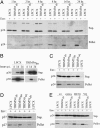Specific recognition and accelerated uncoating of retroviral capsids by the TRIM5alpha restriction factor
- PMID: 16540544
- PMCID: PMC1459386
- DOI: 10.1073/pnas.0509996103
Specific recognition and accelerated uncoating of retroviral capsids by the TRIM5alpha restriction factor
Abstract
The host restriction factor TRIM5alpha mediates species-specific, early blocks to retrovirus infection; susceptibility to these blocks is determined by viral capsid sequences. Here we demonstrate that TRIM5alpha variants from Old World monkeys specifically associate with the HIV type 1 (HIV-1) capsid and that this interaction depends on the TRIM5alpha B30.2 domain. Human and New World monkey TRIM5alpha proteins associated less efficiently with the HIV-1 capsid, accounting for the lack of restriction in cells of these species. After infection, the expression of a restricting TRIM5alpha in the target cells correlated with a decrease in the amount of particulate capsid in the cytosol. In some cases, this loss of particulate capsid was accompanied by a detectable increase in soluble capsid protein. Inhibiting the proteasome did not abrogate restriction. Thus, TRIM5alpha restricts retroviral infection by specifically recognizing the capsid and promoting its rapid, premature disassembly.
Conflict of interest statement
Conflict of interest statement: No conflicts declared.
Figures



Comment in
-
How TRIM5alpha defends against retroviral invasions.Proc Natl Acad Sci U S A. 2006 Apr 4;103(14):5249-50. doi: 10.1073/pnas.0601373103. Epub 2006 Mar 27. Proc Natl Acad Sci U S A. 2006. PMID: 16567650 Free PMC article. No abstract available.
References
Publication types
MeSH terms
Substances
Grants and funding
LinkOut - more resources
Full Text Sources
Other Literature Sources

